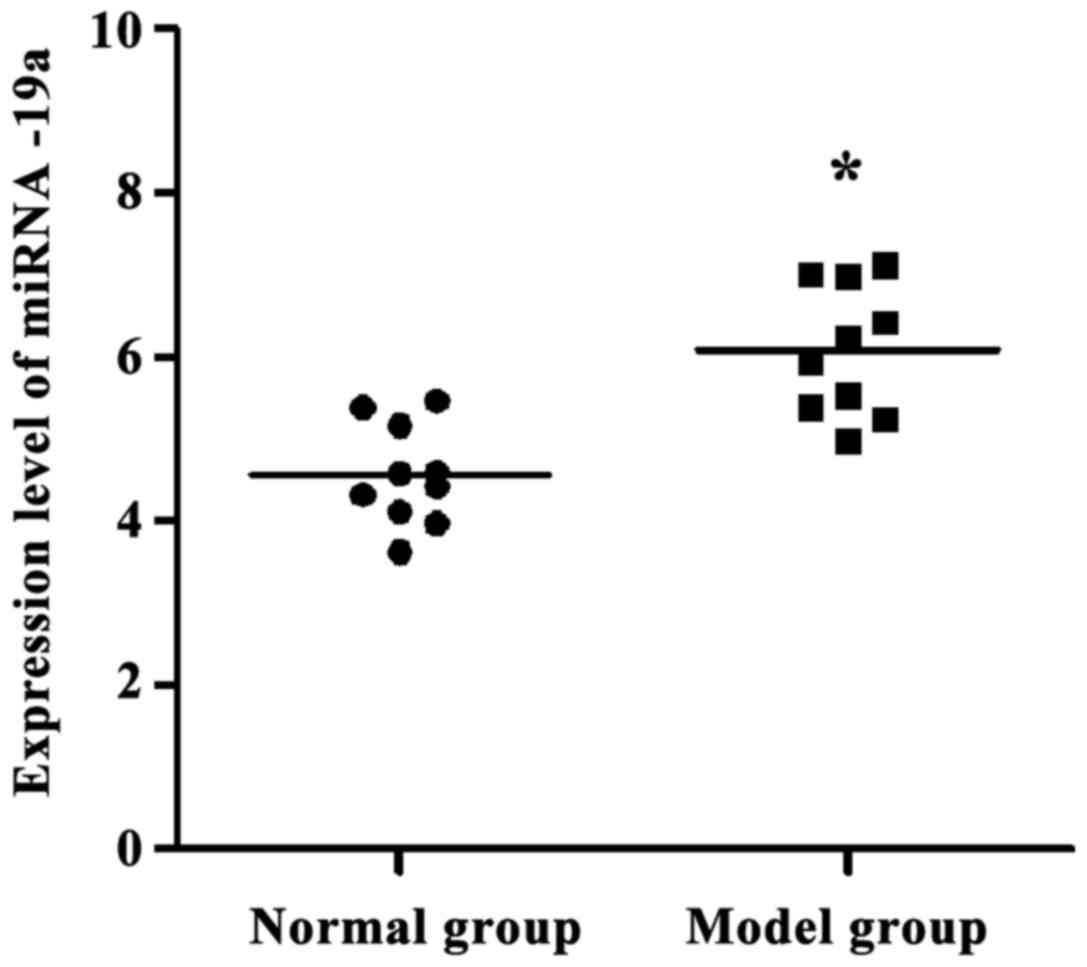|
1
|
Imthon AK, Moeller ME, Drewes AM, Drewes
AM, Juel J and Aziz Q: Functional gastroduodenal disorders. Hamdan
Med J. 8:253–263. 2015.
|
|
2
|
Ghoshal UC, Singh R, Chang FY, Hou X, Wong
BC and Kachintorn U: Functional Dyspepsia Consensus Team of the
Asian Neurogastroenterology and Motility Association and the Asian
Pacific Association of Gastroenterology: Epidemiology of
uninvestigated and functional dyspepsia in Asia: Facts and fiction.
J Neurogastroenterol Motil. 17:235–244. 2011. View Article : Google Scholar : PubMed/NCBI
|
|
3
|
Zhang GS, Xie S, Hu W, Liu RE, Liu ML, Liu
M and Chang XY: Effects of electroacupuncture on interstitial cells
of Cajal (ICC) ultrastructure and connexin 43 protein expression in
the gastrointestinal tract of functional dyspepsia (FD) rats. Med
Sci Monit. 22:2021–2027. 2016. View Article : Google Scholar : PubMed/NCBI
|
|
4
|
El-Serag HB and Talley NJ: Systemic
review: The prevalence and clinical course of functional dyspepsia.
Aliment Pharmacol Ther. 19:643–654. 2004. View Article : Google Scholar : PubMed/NCBI
|
|
5
|
He L and Hannon GJ: MicroRNAs: Small RNAs
with a big role in gene regulation. Nat Rev Genet. 5:522–531. 2004.
View Article : Google Scholar : PubMed/NCBI
|
|
6
|
Wang D, Fan Z, Liu F and Zuo J: Hsa-miR-21
and Hsa-miR-29 in tissue as potential diagnostic and prognostic
biomarkers for gastric cancer. Cell Physiol Biochem. 37:1454–1462.
2015. View Article : Google Scholar : PubMed/NCBI
|
|
7
|
Ueda T, Volinia S, Okumura H, Shimizu M,
Taccioli C, Rossi S, Alder H, Liu CG, Oue N, Yasui W, et al:
Relation between microRNA expression and progression and prognosis
of gastric cancer: A microRNA expression analysis. Lancet Oncol.
11:136–146. 2010. View Article : Google Scholar : PubMed/NCBI
|
|
8
|
Saito Y, Suzuki H, Imaeda H, Matsuzaki J,
Hirata K, Tsugawa H, Hibino S, Kanai Y, Saito H and Hibi T: The
tumor suppressor microRNA-29c is downregulated and restored by
celecoxib in human gastric cancer cells. Int J Cancer.
132:1751–1760. 2013. View Article : Google Scholar : PubMed/NCBI
|
|
9
|
Kapeller J, Houghton LA, Mönnikes H,
Walstab J, Möller D, Bönisch H, Burwinkel B, Autschbach F, Funke B,
Lasitschka F, et al: First evidence for an association of a
functional variant in the microRNA-510 target site of the serotonin
receptor-type 3E gene with diarrhea predominant irritable bowel
syndrome. Hum Mol Genet. 17:2967–2977. 2008. View Article : Google Scholar : PubMed/NCBI
|
|
10
|
Zhou Q, Souba WW, Croce CM and Verne GN:
MicroRNA-29a regulates intestinal membrane permeability in patients
with irritable bowel syndrome. Gut. 59:775–784. 2010. View Article : Google Scholar : PubMed/NCBI
|
|
11
|
Saito Y, Suzuki H, Tsugawa H, Suzuki S,
Matsuzaki J, Hirata K and Hibi T: Dysfunctional gastric emptying
with down-regulation of muscle-specific microRNAs in
Helicobacter pylori-infected mice. Gastroenterology.
140:189–198. 2011. View Article : Google Scholar : PubMed/NCBI
|
|
12
|
Abdel-Aziz H, Wadie W, Zaki HF, Müller J,
Kelber O, Efferth T and Khayyal MT: Novel sequential stress model
for functional dyspepsia: Efficacy of the herbal preparation STW5.
Phytomedicine. 22:588–595. 2015. View Article : Google Scholar : PubMed/NCBI
|
|
13
|
Talley NJ: Functional dyspepsia: New
insights into pathogenesis and therapy. Korean J Intern Med.
31:444–456. 2016. View Article : Google Scholar : PubMed/NCBI
|
|
14
|
Hao M, Zang M, Wendlandt E, Xu Y, An G,
Gong D, Li F, Qi F, Zhang Y, Yang Y, et al: Low serum miR-19a
expression as a novel poor prognostic indicator in multiple
myeloma. Int J Cancer. 136:1835–1844. 2015. View Article : Google Scholar : PubMed/NCBI
|
|
15
|
Feng Y, Liu J, Kang Y, He Y, Liang B, Yang
P and Yu Z: miR-19a acts as an oncogenic microRNA and is
up-regulated in bladder cancer. J Exp Clin Cancer Res. 33:672014.
View Article : Google Scholar : PubMed/NCBI
|
|
16
|
Baik SH, Lee J, Lee YS, Jang JY and Kim
CW: ANT2 shRNA downregulates miR-19a and miR-96 through the
PI3K/Akt pathway and suppresses tumor growth in hepatocellular
carcinoma cells. Exp Mol Med. 48:e2222016. View Article : Google Scholar : PubMed/NCBI
|
|
17
|
Yamamoto K, Ito S, Hanafusa H, Shimizu K
and Ouchida M: Uncovering direct targets of miR-19a involved in
lung cancer progression. PLoS One. 10:e01378872015. View Article : Google Scholar : PubMed/NCBI
|
|
18
|
Huang L, Wang X, Wen C, Yang X, Song M,
Chen J, Wang C, Zhang B, Wang L, Iwamoto A, et al: Hsa-miR-19a is
associated with lymph metastasis and mediates the TNF-α induced
epithelial-to-mesenchymal transition in colorectal cancer. Sci Rep.
5:133502015. View Article : Google Scholar : PubMed/NCBI
|
|
19
|
Lu W, Xu Z, Zhang M and Zuo Y: MiR-19a
promotes epithelial-mesenchymal transition through PI3K/AKT pathway
in gastric cancer. Int J Clin Exp Pathol. 7:7286–7296.
2014.PubMed/NCBI
|
|
20
|
Yang F, Wang H, Jiang Z, Hu A, Chu L, Sun
Y and Han J: MicroRNA-19a mediates gastric carcinoma cell
proliferation through the activation of nuclear factor-κB. Mol Med
Rep. 12:5780–5786. 2015. View Article : Google Scholar : PubMed/NCBI
|
|
21
|
Sanger GJ and Furness JB: Ghrelin and
motilin receptors as drug targets for gastrointestinal disorders.
Nat Rev Gastroenterol Hepatol. 13:38–48. 2016. View Article : Google Scholar : PubMed/NCBI
|
















